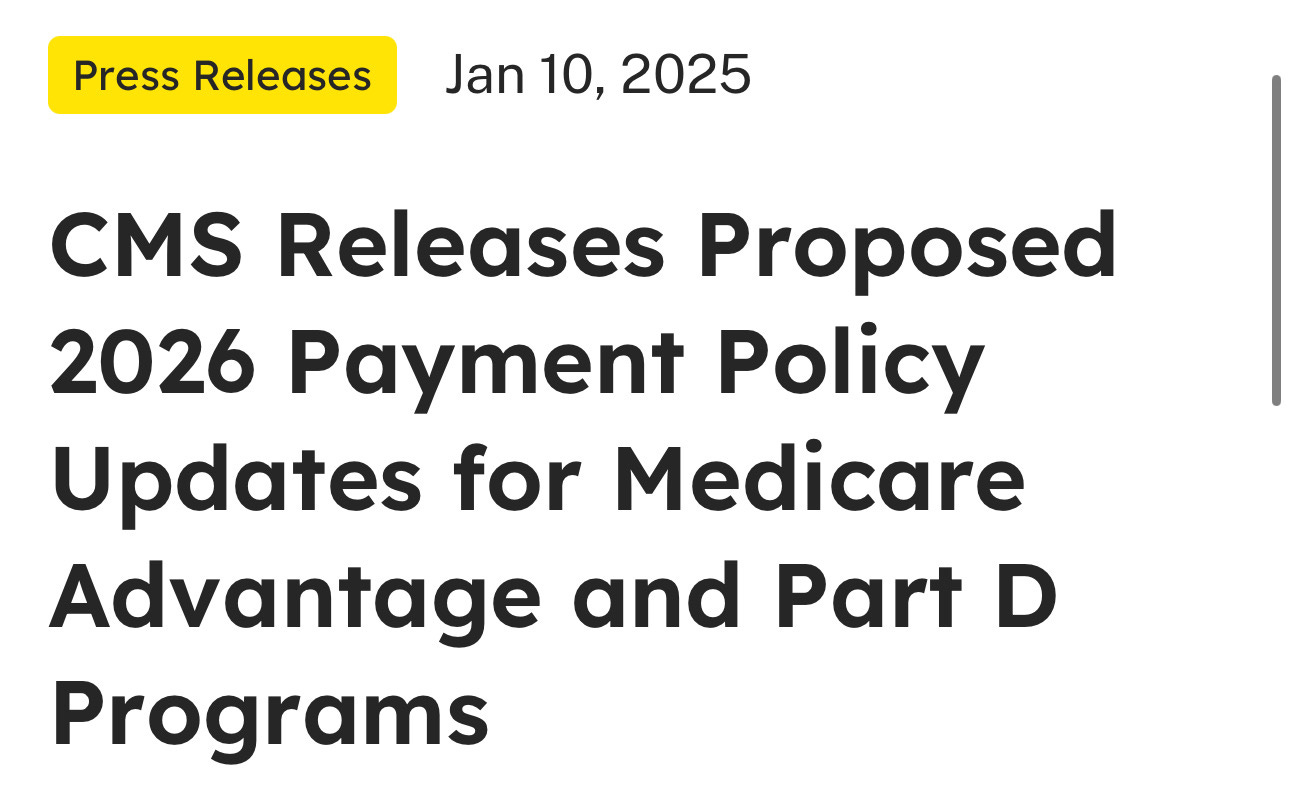Comprehensive Analysis of the 2026 Medicare Advantage (MA) and Part D Advance Notice: Impacts and Industry Reactions
The 2026 Medicare Advantage and Part D Advance Notice released by CMS signals substantial changes for the Medicare ecosystem, driven largely by payment reforms and the ongoing implementation of the Inflation Reduction Act (IRA). This essay explores the updates, delves into potential industry impacts, and outlines how these changes align with CMS’s overarching objectives for cost containment, equity, and sustainability.
Key Policy Updates and Objectives
Payment Growth and Risk Adjustment
CMS proposes a 4.33% average net increase in MA payments for 2026, accounting for over $21 billion in additional funds. The growth rate is primarily fueled by:
1. Effective Growth Rate (5.93%): Reflecting Medicare Fee-for-Service (FFS) cost growth.
2. Risk Adjustment Model Completion: A transition to the 2024 CMS-HCC risk adjustment model, incorporating ICD-10 codes and updated expenditure trends.
3. Star Rating Adjustments (-0.69%): Quality Bonus Payment reductions tied to Star Rating changes.
The proposed payment increase supports program stability but comes with nuanced adjustments. For instance, the -3.01% adjustment tied to risk model updates and normalization highlights CMS’s efforts to improve payment accuracy. Notably, CMS plans to phase out additional MA-related medical education costs, reducing excess payments and redirecting funds for more predictable allocations.
Inflation Reduction Act (IRA) and Part D Redesign
Several IRA-driven updates will reshape the Part D landscape:
1. Cost Caps for Beneficiaries:
• A new $2,100 annual out-of-pocket cap (up from $2,000 in 2025) shields beneficiaries from catastrophic drug costs.
• Insulin products will see monthly cost caps of $35 or 25% of negotiated prices.
• Vaccines recommended by the Advisory Committee on Immunization Practices will remain free.
2. Drug Price Negotiations:
• The Medicare Drug Price Negotiation Program begins in 2026 with ten high-cost Part D drugs subject to reduced, CMS-negotiated pricing.
• Subsidy programs will offset drug costs for sponsors, reducing liability and balancing systemic impacts.
3. Selected Drug Subsidy:
• CMS introduces a 10% government subsidy for selected drugs in early benefit phases, reducing plan liabilities.
Star Ratings and Quality Measures
CMS is advancing its focus on health equity and clinical outcomes:
• Simplification of Star Ratings to prioritize measures of clinical care, outcomes, and patient experience.
• Incorporation of geographic health equity indexes to reward plans addressing regional disparities.
PACE and Encounter-Based Models
PACE organizations will begin transitioning to the 2024 CMS-HCC risk adjustment model. This gradual implementation ensures a smoother transition for providers serving medically complex populations, with plans to fully shift by 2029.
Industry Impacts
Increased Payment and Operational Recalibration
The payment increase provides financial relief to MA organizations but demands operational recalibration:
1. Risk Adjustment Model Completion:
• The full transition to the 2024 CMS-HCC model will require plans to reassess data accuracy and coding strategies. Smaller plans serving less-risky populations may face reduced reimbursements, necessitating cost-efficiency strategies.
2. Star Rating Adjustments:
• Reduced Star Rating bonuses (-0.69%) will disproportionately affect plans with average ratings, pushing insurers to double down on quality improvement initiatives and patient engagement strategies.
3. IRA Cost Controls:
• Insurers will experience lower liability for high-cost drugs but must balance premium stability with rising administrative and benefit costs.
Pharmaceutical Sector and Drug Pricing
The Medicare Drug Price Negotiation Program introduces significant pressure for pharmaceutical companies:
1. Reduced Margins for High-Cost Drugs:
• Drug manufacturers face pricing constraints on selected medications, with negotiated prices lowering profit margins.
2. Generic Substitution Policies:
• Sponsors may now immediately substitute selected drugs with generics when available, accelerating shifts in formulary management.
These changes may compel drug manufacturers to reprioritize portfolios, invest in alternate markets, or negotiate new arrangements with insurers.
Beneficiary Experience and Equity
Beneficiaries stand to benefit significantly:
1. Out-of-Pocket Protections:
• The $2,100 cap ensures affordability for those with chronic illnesses requiring expensive therapies.
2. Broader Access to Preventive Care:
• The zero-cost-sharing policy for vaccines and insulin caps aligns with broader public health goals.
The geographic health equity index rewards plans that address underserved populations, indirectly incentivizing insurers to innovate in care delivery models.
Strategic Adjustments for Stakeholders
Insurers and Providers
To thrive in this evolving landscape, insurers must:
1. Enhance Data Integrity:
• As the 2024 CMS-HCC model emphasizes predictive accuracy, insurers must ensure robust data collection, especially in areas like encounter data submission.
2. Focus on Equity:
• New health equity metrics in Star Ratings encourage investments in outreach and culturally competent care delivery.
Pharmaceutical Companies
Manufacturers should prepare for:
1. Pricing Adjustments:
• Adjust product strategies in light of IRA-driven price caps and formulary changes.
2. Broader Engagement:
• Collaboration with CMS and insurers to maintain access for high-cost therapies.
Policymakers
CMS must monitor unintended consequences:
1. Drug Access:
• Ensure negotiated pricing does not lead to reduced drug availability or innovation slowdowns.
2. Risk Model Adaptation:
• Balance model updates with stability to avoid abrupt disruptions for plans and beneficiaries.
Conclusion: A Dynamic Healthcare Landscape
The proposed 2026 updates to Medicare Advantage and Part D reflect CMS’s dual commitment to affordability and sustainability. While beneficiaries will benefit from cost caps and broader access, insurers, providers, and manufacturers face operational and financial realignments. These changes underscore the need for industry stakeholders to adopt proactive strategies to balance regulatory compliance with innovation and quality improvements. By fostering collaboration across the ecosystem, the healthcare sector can navigate these shifts while improving patient outcomes and equity.


